“My knockout is out of control!” a reader told me. “How do I prune it?” Knockouts are one of the many varieties of shrub or landscape roses, and many people are surprised by how large they typically grow. I’d urge you all not to think of these are “out of control,” however. They are not running around starting fires, stealing cars, or abducting children. That would be out of control. No, these shrubs are merely growing to be the size and shape their genetics dictate. Yes, they may need a good pruning or even a complete renovation, but this is usually because the gardener has ignored them for a few years, and now they are a thorny ball of living and dead stems.
Here are the steps for renovating a shrub rose. There are two ways to do this: a drastic renovation, and a partial-renovation that is a very thorough pruning. The goal for each is to improve appearance and stimulate new growth. Let’s look at the partial renovation first, since this will be most suitable for those who still want flowers after pruning.
UPDATE PHOTOS BELOW 5/21/20222

This is how my shrub rose looked today. I’ve done minimal pruning on this plant for the past five years. It’s time to get in there and clean it up! But I’m not ready to do a drastic, cut-to-the-ground pruning. (More about that later.) So I start by looking at this plant and finding the biggest, oldest stems.
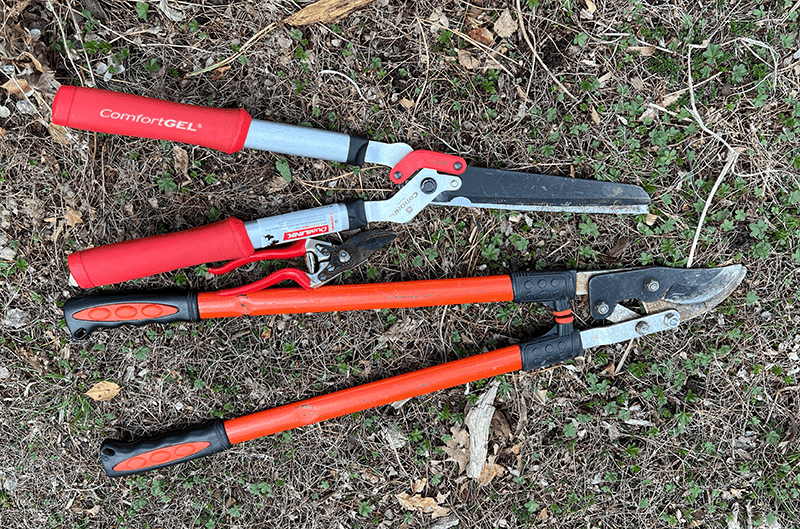
These are the tools you’ll need for a good pruning of a shrub rose. On the top, hedge trimmers. In the center, a pair of good by-pass hand pruners. (Spend the big bucks for these if you can. When it comes to pruners, you get what you pay for and a good pair make pruning SO much easier and faster.) Below, by-pass lopers. Lopers are like a hand pruner but larger, so they can cut thicker branches, and with longer handles. The long handles of lopers are especially valuable for roses since you’ll want to be able to get into that thorny bush to cut, without getting pricked yourself.
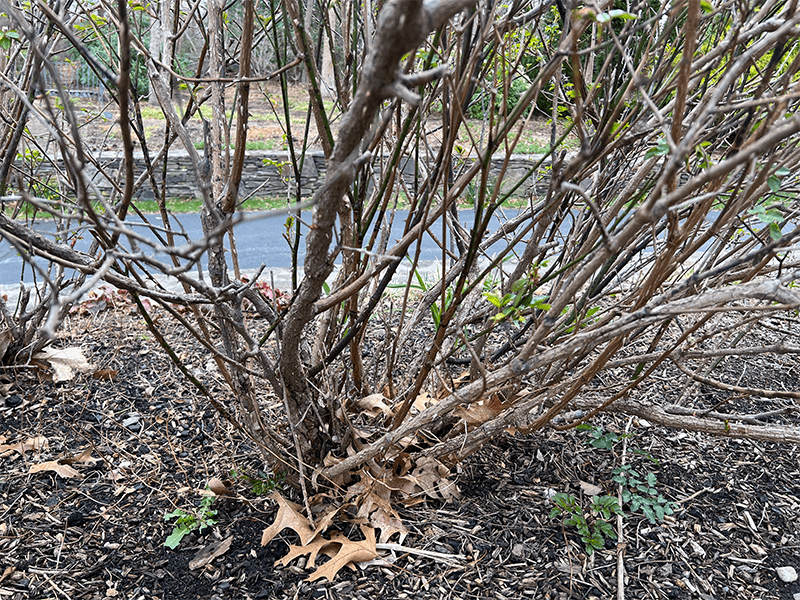
Look at the base of the rose bush and locate the largest, oldest stems. The age of the rose and how long it has been since it has been pruned will determine how many large, old stems there are. On this plant we can see at least 3 very old stems and 2 that are close. This year I will cut the 3 oldest, leaving the others for next year or the year after.
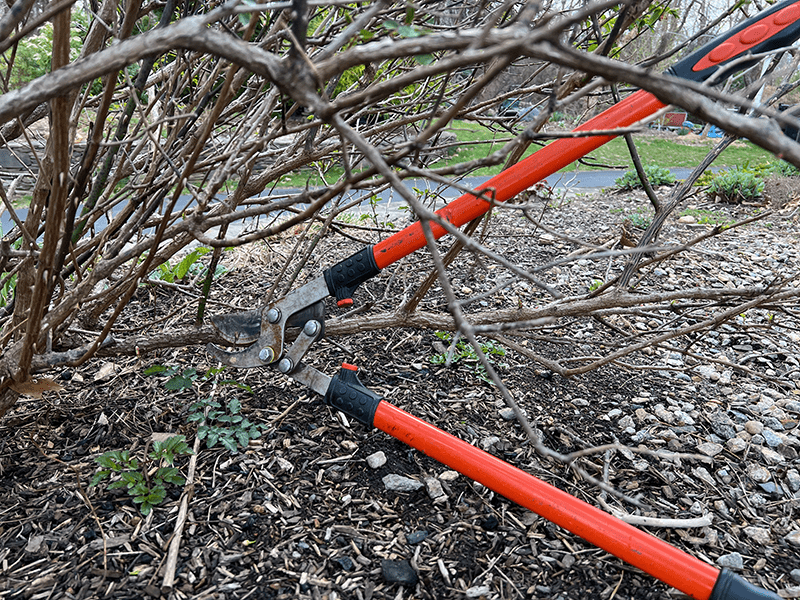
Use the lopers to cut the oldest canes (aka stems) back toward the base of the plant. You can leave about 6 to 8 inches of the stem, since new growth might be produced from below that cut.

This is another large, old cane that will get cut way down. This removal of oldest stems is important because it stimulates growth of newer, more vital canes. Once you cut these large, older stems, use the lopers to grab them without cutting, and pull them free of the shrub.

Now look at the plant and find any curved, weak or funky shaped branches. Look for those growing into the center of the plant instead of flowing out, away from the middle. Remove those that you see. The arrow points to a funky shaped branch that goes into the center, so I am cutting that out near the ground.

The next step is to remove dead stems. If you wish, this can be started by using a hedge trimmer to cut the dead tips and last year’s seed pods. You can go chop-chop-chop with the hedge trimmers, to remove these off the top. You’ll still need to go back with the hand trimmers to remove all the other dead stems throughout the rose bush. But this can be a fast start in this process.
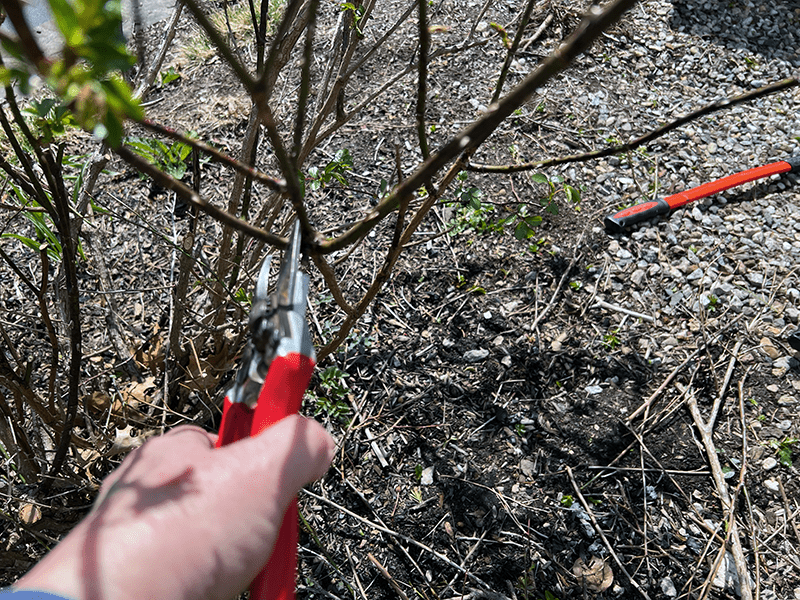 Now look very carefully and identify all dead or “mostly dead” stems. Remove them completely. Take your time – this process isn’t one that should be rushed. Rela
Now look very carefully and identify all dead or “mostly dead” stems. Remove them completely. Take your time – this process isn’t one that should be rushed. Rela

Here you see the pile of dead stems at the base. The more you look at your plant, the more deadwood you’ll find.

After all the dead stems are gone, look for any remaining canes that go into the center of the shrub, or are odd or funky looking. Remove those, and then clip a bit off the top – about 6 to 12 inches. Make the cut just above a bud that faces out, away from the center if you can. Know that every green shoot you leave will become a stem with flowers at the end. Roses produce blooms on new growth. So leaving all of these branches with green growth will result in a plant that has a good amount of flowers this year. I have removed about 1/3 of this plant’s total stems.
The more drastic renewal pruning is when you cut the rose down closer to the ground. This isn’t the preferred way to prune Knockout roses and other shrub varieties, but it might be necessary. Rose bushes don’t always recover from such a major renewal pruning, and they won’t flower much the first year after you cut the down, Occasionally this type of pruning will trigger growth from below the graft – watch for fast, straight-up shoots that come from the ground, not the stems above the ground. Growth that comes from below the graft will have different flower shapes and colors.
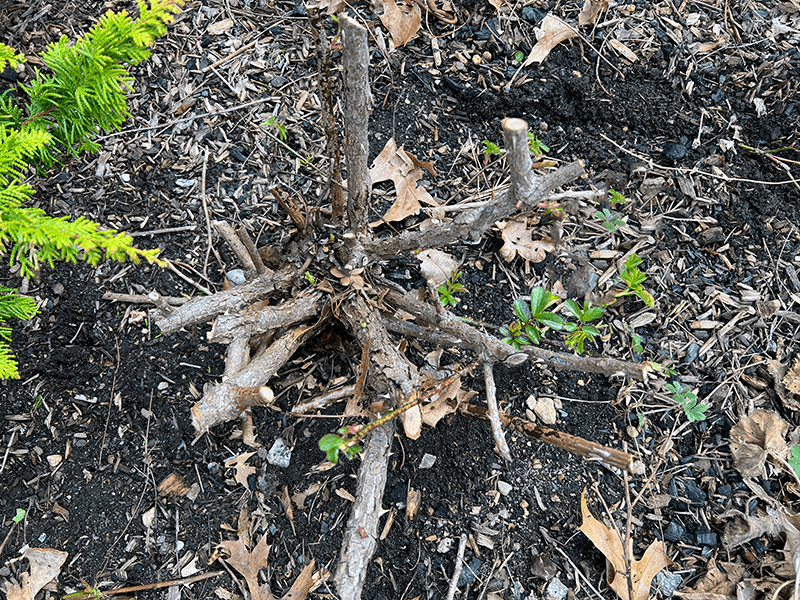
The other, much more drastic way to renovate shrub roses is to cut all of the stems down to about 6 inches tall. In most cases the plants will come back, but in some instances you will not get strong, return growth. So only do this is you are desperate and willing to let the plant go. If the rose bush does recover, you will need to wait at least two years before it looks good again. And you’ll need to be prepared to clip it and tweak the new growth so that it develops a full, balanced shape. If you go with this method, sprinkle an organic fertilizer around the area and then top-dress around the cut stems with compost or composted manure after you prune. Through the rest of the summer, water these plants deeply once a week if nature doesn’t deliver at least an inch of rainfall. Mulch over the compost to hold moisture in the soil and discourage weeds.

I had three shrub roses in this area. One was pruned as first described in this blog, by removing about a third of the plant’s total growth. The other two were given the drastic, down to 6″ renovation pruning. I’ll post followup photos later in the summer to show how all of these plants are doing.

The older your shrub rose, the more time it will take to prune it. Needless to say, the drastic renovation that you see on the two plants on the right is faster, but not the first choice for most plants. Know that even with the thoughtful cutting that I did on the plant on the left, there is more that could be done! There is a stem that grows from the right side into the center and to the left, for example. I will cut that out next year.

Shrub roses are wonderful in that they are disease resistant and repeat flowering.
If your shrub rose is newer, and doesn’t need renovating, prune it by first taking out all dead stems and the tips of the canes that have died back over the winter. Next look for stems that are heading into the center of the plant instead of moving out and away – remove those by cutting them near where they join another branch. Last, clip branches back from the top down, cutting just above an outward facing bud.

Here is one of the shrub roses that I did a renovation pruning on, cutting it down to about 6″ from the ground. It’s filled with new growth! I’ll post photos later in the summer to show you how this plant has been rejuvenated .

Update on May 2st: This is the base of the plant that I didn’t cut all the way down, but removed some of the largest, oldest canes. See all of the new growth below? The shrub still has new growth on the top, which will produce flowers soon, but there are also new stems forming here on the bottom, that will fill out this summer.

This was very helpful. Roses are one plant I’ve never had coz I don’t like plants that hurt me and I have thin skin from steroid shots for arthritis. BUT each year I see how gorgeous they are- those that er loom into September. This year I’m getting roses. Going to Roseland
I hired a guy to weed my yard. When he was “finished” he hadn’t pulled any weeds but had only pruned all my beautiful shrub roses. Some he pruned down to nothing but a few sticks and the others he shaped into little trees by shaving everything off one main stick and leaving some bush about 3 ft off the ground. Having rose trees instead of the healthy round shrubs does not fit my landscape style. There are six of them that have been growing for 7 years into beautiful balls of roses. I’m so sad! Will they grow back? What can I do?
Yes, roses pruned “down to nothing” usually come back from the base of the stems, especially if they were shrub roses. You’ll know in the spring. Apply some fertilizer once they start to grow again.
thank you! I learned a lot… my rose bush is only 2 years old and and grew a lot in just 2 years so this will help me to keep it from getting out of control.
I have rose bushes in my yard that my grandfather planted over 50 years ago. I had to move them so a mason could do work on the front steps. Moved them back and so far so good. I see buds! I have done light trimming over the years but now that I know the correct way to shape them, this will be my goal. Thank you for sharing your wealth of knowledge.
Do you cut off old blooms, and will they bloom again, looks like it’s getting new growth
Most roses rebloom faster if you cut off fading and wilted flowers.
I planted a new rose bush this past summer. The stems and canes are green. Should i cut the ends were the flowers were now. Should i do any other cutting on a new bush. It’s about 3 feet tall. I have another small rose bush just planted last summer and still has green leaves but a few dead canes in the middle coming from the ground. Should i cut those?
Fred
If you want to trim off the ends where the flowers were you can, although many like the way some roses make seed pods, which are called “hips.” But don’t do much other cutting until spring. In the spring, when the plant breaks dormancy and makes small reddish shoots, you can trim it back to remove winter-killed ends, crossed/rubbing branches or any growth that looks odd or injured.
Most roses rebloom best if you clip off fading flowers
I have a mini rosebush that I’ve kept inside during winter, on deck in summer, for the past 2 yrs. Can I plant it in the ground. I live in southern Wisconsin
On Wisconsin! (I grew up in Stevens Point) Some of these mini-roses are hardy outside but others are not. They are bred, selected and grown as greenhouse gift plants, not as landscape plants. If you’re willing to chance that it won’t make it through the winter next year, plant it in a sunny but protected spot in the spring and hope for the best. Wishing you and early spring, C.L.
I have a bush rose. I’ve been nurturing it for 5 years and had my best year summer 2023. I live in SE Michigan, zone 5.
I don’t know how much to prune for the upcoming winter.
Can I prune it so it fits into a 24″ rose cone or should I fashion a burlap cage to encompass the branches? ( which I’d rather avoid)
Michele – don’t prune it before winter. A shrub rose does not need a rose cone or burlap cage in my experience. They are bred for colder areas unlike the hybrid teas that need such protection. If you’re uncomfortable with my advise, by all means cut it and protect it as you wish.
I was gifted a throwaway knockout rose from a neighborhood list serve. It was about 4’ tall. The owner had pruned it quite a bit, and dug it up along with native soil just before I came to pick it up. I took it straight home and planted it. After about 10 days, it looks awful. All the blooms have died and most of the branches are dry and brown.
I’m sure it’s in shock, but will it come back, and what can I do to help that?
Yes, it’s in transplant shock. You can water it deeply every three days if you’re in a location where the nights are still going below 60° or every two days if you’re in a place that’s warmer. Be sure to water the area a foot beyond the dripline as well, because if the soil next to the rootball is dry it will suck the moisture away from the plant. Clip off the spent flowers. DO NOT FERTILIZE. That can make things worse. Once the plant starts to put out some new growth, you can clip off anything dead and apply some Rose-tone fertilizer lightly around the plant. At this point, it’s all about getting the root system reestablished.
When is the best time of year to do a “partial-renovation”? We are in mid-July (north Georgia) and it’s pretty hot but our knock-outs are looking very spindly and weak. Too many teeny tiny branches and probably a few woody ones. Can we do a partial now? Or will it be best to wait until early Spring next year? Thanks!
Only do a partial renovation in the spring. You’ll be rewarded and won’t stress the plant, or cause it to die.
Thank you so much. Very informative and helpful.
I just recently cut down all my knockouts. They were straggling and I had it with them. I cut them all down to 6 inches. Within 1 week I had new growth. Within a couple of week , lots of roses. They look great. Of course I live in Florida. Everyday is growing season. I plan on keeping the bushes shorter now.
Just remember that the shorter you cut them down the fewer flowers you have every year. If you get sick of fighting their height, consider the Drift series of roses – they are just as reliable about repeat blooming and are shorter.
I live in Reno. When is best time to trim back roses, especially knockouts?
Prune them when their red buds are swelling and starting to – at that time you can clearly see what’s living and what’s dead.
What can I use on my knockout rose bushes to stop the leaves from being eaten during late spring?
Honey, Hard for me to comment if I don’t know what’s eating the rose leaves. If it’s rabbits or deer, spray with Plantskydd. If it’s the rose-slug-budworm, use a product with spinosad, such as Captain Jack’s Deadbug Brew.
My knock out roses are blooming wonderfully but when we have a heavy rain the heavier branches drop to the ground
Maybe too much fertilizer? Fertilizers promote fast, weak growth. These roses are generally very stem-sturdy.
It’s LOPPER, not LOPER. We’re lopping off length with these cutters
Yes!